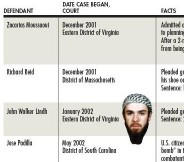31 Wins, 6 Losses & 1 Tie
<a href=”http://abajournal.com/files/09-2007/09TRROR.pdf” title=”
Click image for the chart.
How well is the U.S. Department of Justice faring in its legal war against al-Qaida and its former state sponsor, the Taliban?
To find out, we reviewed DOJ’s Counterterrorism White Paper (PDF), issued in June 2006, and subsequent court documents. The 68-page white paper, listing dozens of terrorism-related cases, is arguably the department’s most comprehensive public accounting of its terrorism successes and failures since 9/11.
It includes what DOJ considered the major pending cases at that time. Below are the 38 defendants who were charged since 9/11 with fighting for, providing material support to, or financing al-Qaida or the Taliban, and whose cases have been disposed of by a U.S. District Court as of late July 2007. Many of the cases remain on appeal.
Since 9/11, Justice Department officials have repeatedly said they will use minor charges to convict individuals they believe are terrorists—much as gangster Al Capone was convicted of tax evasion—in an effort to thwart another attack. But absent a conviction on terrorism charges, it is impossible to say for sure that those individuals are terrorists since, as DOJ officials also often say, defendants are presumed innocent until proven guilty.
Consequently, this chart (PDF) evaluates the strength of the government’s cases, not whether the defendants were terrorists. It scores each case based on whether the government proved—either by a defendant’s plea or a conviction after a trial—the indictment’s charges of supporting al-Qaida or the Taliban. The cases are listed in chronological order, based on when legal proceedings began.




